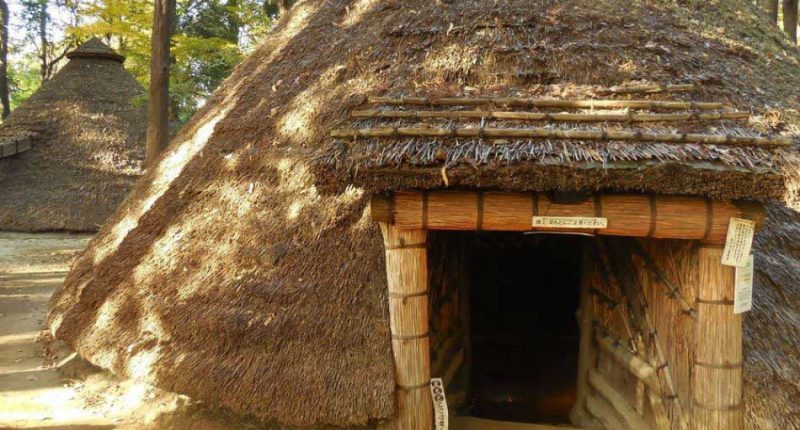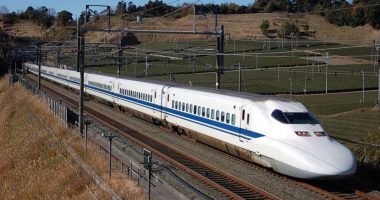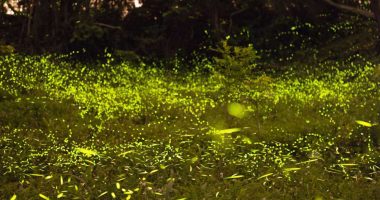The first humans to inhabit Japan walked over from the mainland around 35,000 BCE at a time when the northwestern tip of Hokkaido was connected to the eastern extremities of Russia. Evidence of cord-marked pottery and the foundations of a basic society gave rise to Japan’s first documented period—the Jomon period. The Jomon were largely a hunter gather culture who subsisted for the best part of 10,000 years before a more advanced people, the Yayoi, sailed over the narrow sea from the Korean peninsula around 500 BCE. These new-comers gradually came to dominate the regions from the south of Japan up to northern Honshu, and today it is understood that Japanese are ancestors of interbreeding between these two early inhabitants.
The following centuries witnessed the emergence of a basic social structure, primitive bronze and iron tools, and farming techniques (rice cultivation being the most notable). But piecing together the archaeological fragments to form an accurate picture of Japanese society at this time is made even more challenging because no written documents exist. In fact, the only records we have of Japan before the 8th century come from Chinese texts, which refer to a country called Wa in the east. What we do know is that by 250 CE a ruling state had emerged which held control over the land from northern Kyushu to the Kanto plains, and ruled from modern-day Nara Prefecture.
These early centuries also witnessed Shinto (“way of the gods”) take root. The followers of Shinto, a religion indigenous to Japan, worship multiple kami (gods or spirits) who reside in natural objects such as mountains, trees, and rocks, or manifest themselves in phenomena such as wind and thunder. For a people whose existence depended so heavily on the rice harvest, the evolution of a religion with nature at its center seems almost logical. Indeed, it is thought that the title of emperor evolved from the position of Shinto chief priest, and folklore—which provides the only historical accounts for Japan’s beginnings—holds that the first emperor descended from the sun goddess Amaterasu. Although fiction gives way to blurred facts in later historical texts, this notion that the emperor descended from a deity persisted throughout the millennia such that in the immediate aftermath of World War II the U.S. forced Emperor Hirohito to declare his humanity to the nation.
Japan’s other main religion, Buddhism, crossed over from Korea in the middle of the 6th century when Seong of Baekje, king of one of the three kingdoms of Korea, sent a mission to Nara bearing a statue of the Buddha and copies of the sutra. Buddhism found little ground at first: the statue was thrown into the sea after a plague, believed to have been brought upon the people by a native sun goddess offended that her subjects would pray before a foreign deity, ravaged the land. It was the adoption of Buddhism by the Soga clan—coupled with their subsequent rise to power—that is thought to be the greatest contributing factor to the propagation of the religion in Japan.
While Shinto and Buddhism came to jointly shape rituals and beliefs, the teachings of Confucius, which had crossed over from Korea along with the first writing system, provided the framework for an administrative and legal system. The Seventeen Article Constitution authored by Prince Shotoku in 604 CE and the subsequent Taika Reforms in 645 CE jointly gave rise to Japan’s first constitution. Based almost entirely on the ritsuryo, a legal system of penal and administrative codes heavily influenced by Confucianism, they gave weight to the notion of patriarchal rule and laid the foundations for a male-dominated society.
At the beginning of the Heian period (794-1185) the subjugation of the northern Emishi people—descendants of the early Jomon who had largely remained outside the sphere of influence of the government in the south—brought further unification for Japan, and the capital relocated from Nara to Heian city (present day Kyoto), where it would remain until 1868. The Heian period witnessed a proliferation of art and culture, and history has bestowed on it a somewhat romantic image. The Tales of Genji—considered to be the world’s first modern novel—was written during this period and the waka (a type of short Japanese poem) flourished. But it was the gradual rise of the samurai class—an event that would go on to shape much of Japan’s history during the 2nd millennium—for which the Heian period is best known.
The idea of a central government in Kyoto with the emperor at its head does not quite paint a true picture of the political landscape during these times. In fact, powerful warlords with their own armies dominated the regions outside Kyoto, and with the end of conscription in 792 CE the emperor was forced to rely on these clans to quash rebellions and keep control. His grip on power was not strong, having to constantly offer concessions in return for their loyalty. This gradual weakening of central power can be seen through the shoen. With the introduction of the ritsuryo in the mid-7th century, all lands had been declared property of the government on which a tax was to be levied to support the administration. But lands classified as shoen were granted a tax-free status and offered as rewards to those who pledged their allegiance to the emperor. By the 12th century around half of Japan’s arable land was classified as shoen, considerably eroding the revenue stream flowing towards the government.
It is important to take a step back and put the power dynamic between the government—or ruling clan—and the emperor into some context, especially because it helps to explain why despite the internal power struggles and rise of the samurai class over the following centuries the emperor never lost his position as the nominal head of Japan.
As mentioned, it was a deep-rooted belief that the emperor descended from the deity Amaterasu—something which was even documented in the Kojiki (“Record of Ancient Matters”), Japan’s oldest extant historical text (early 8th century). And as the celestial representative of the people, the emperor gave legitimacy to the ruling government—a façade behind which they could pull the political strings of the administration. An attempt on the emperor’s life, for example, in a bid to gain complete control would only open the perpetrators up to charges of being improper rulers of Japan, and allow competing factions to edge their way to power. Thus, while his power waned, the emperor remained protected by a mythological cloak which no warlord—no matter how ruthless—was so shortsighted as to pierce.
As the balance of power shifted outwards, the government increasingly became a passive observer in the struggles occurring outside Kyoto. A succession dispute for emperor in 1155 set off a 40-year-long chain of events that ended with Minamoto no Yoritomo establishing the Kamakura bafuku—Japan’s first shogunate—and receiving the title of seii-taishogun (“The Conqueror of Barbarians”) from a now-figurehead Emperor Go-Toba in 1192. The warrior class (samurai) would be the de facto rulers of the country, operating more or less independently from the court in Kyoto, for 700 years until the Meiji Restoration in 1868 re-consolidated power back in the hands of the emperor.
- Next: Samurai Rule & Civil War





